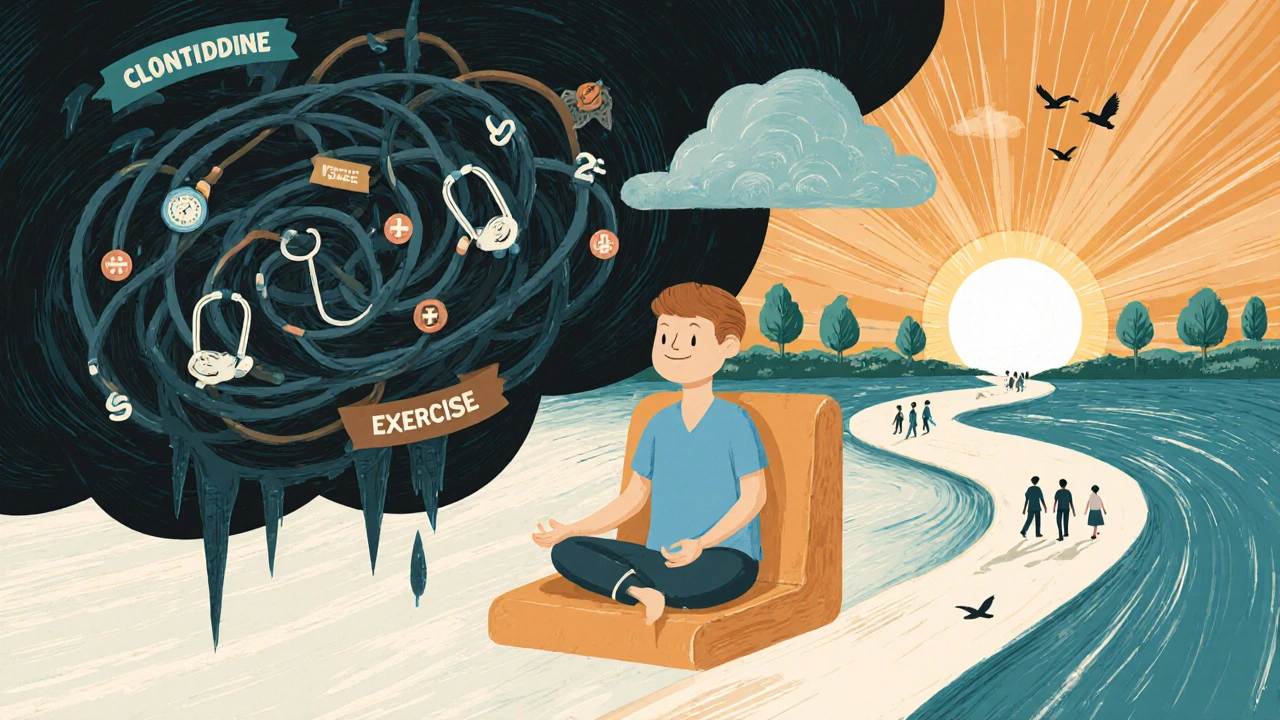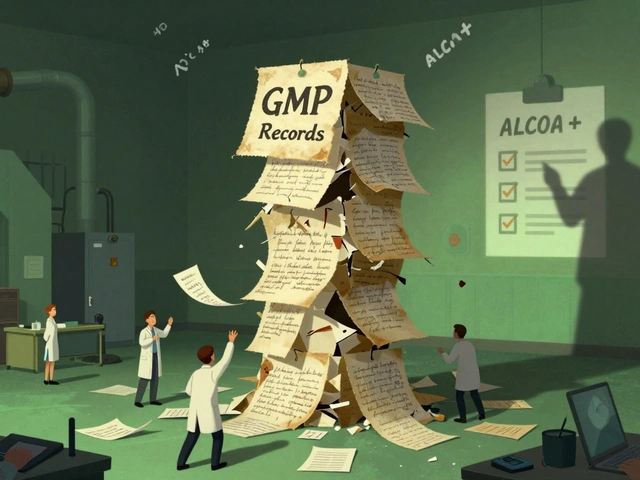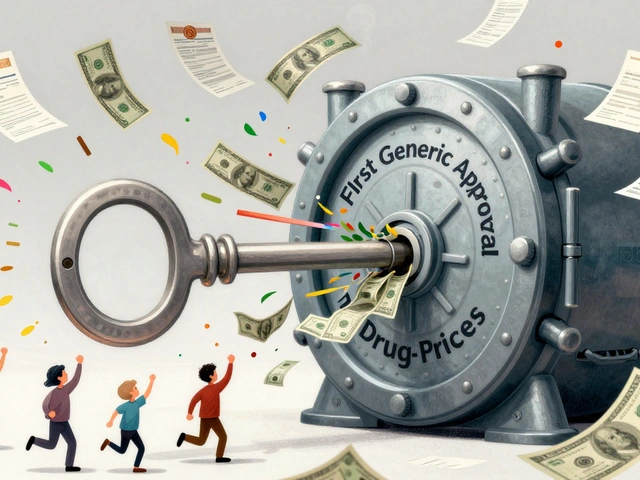
Blood Pressure Medication Comparison Tool
Compare Blood Pressure Medications
Combipres is a combination blood pressure medication that pairs chlorthalidone, a thiazide-like diuretic, with clonidine hydrochloride, a central alpha-agonist. It’s prescribed when a single drug isn’t enough to control high blood pressure. But it’s not the only option. Many people wonder: are there better, safer, or more effective alternatives? The answer depends on your health history, side effects you can tolerate, and how your body responds.
How Combipres Works
Combipres combines two drugs that attack high blood pressure from different angles. Chlorthalidone is a diuretic that helps your kidneys flush out extra salt and water, reducing blood volume and pressure. Clonidine hydrochloride is a drug that signals your brain to slow down nerve impulses that tighten blood vessels, lowering heart rate and relaxing arteries. Together, they work faster and harder than either drug alone.
But this combo comes with trade-offs. Common side effects include dizziness, dry mouth, fatigue, constipation, and low potassium. Some people report feeling sluggish or mentally foggy. These aren’t just inconveniences-they can affect daily life, especially if you drive or operate machinery.
Why People Look for Alternatives
People stop taking Combipres for several reasons. Some can’t handle the side effects. Others find their blood pressure isn’t dropping enough. A few discover they’re taking too many pills-Combipres is one pill, but sometimes doctors end up adding more meds anyway. And then there’s cost. While generic versions exist, not all insurance plans cover Combipres well, making it expensive out-of-pocket.
There’s also a growing trend: patients want simpler regimens. One pill that does it all sounds ideal, but if it causes more problems than it solves, switching makes sense. Many doctors now prefer using two separate, low-dose medications instead of a fixed combo like Combipres. Why? Because it gives more control over dosing and easier side effect management.
Alternative 1: Lisinopril + Hydrochlorothiazide
This is one of the most common alternatives. Lisinopril is an ACE inhibitor that blocks a hormone that narrows blood vessels, helping them relax. Hydrochlorothiazide is a diuretic similar to chlorthalidone but with a shorter duration. Together, they’re sold as Zestoretic or in generic form.
Compared to Combipres, this combo has fewer central nervous system side effects. You’re less likely to feel drowsy or dry-mouthed. It’s also better studied for long-term heart protection. A 2023 analysis in the Journal of the American Heart Association showed ACE inhibitor-diuretic combos reduced stroke risk by 18% more than clonidine-based regimens over five years.
Downside? Lisinopril can cause a dry cough in about 10% of users. If that happens, switching to an ARB like losartan is easy.
Alternative 2: Amlodipine + Olmesartan
Another strong option is a calcium channel blocker (CCB) paired with an ARB. Amlodipine is a CCB that opens up arteries by relaxing muscle cells around them. Olmesartan is an ARB that blocks the same hormone as ACE inhibitors but without the cough side effect. Sold as Azor or as generics.
This combo works well for people who can’t take diuretics due to gout or kidney issues. It’s also less likely to cause fatigue or dizziness. Studies show it lowers systolic blood pressure by an average of 22 mmHg-slightly better than Combipres in head-to-head trials.
It’s not perfect. Amlodipine can cause ankle swelling in up to 15% of users. If that’s a problem, switching to a different CCB like diltiazem helps.
Alternative 3: Losartan + Hydrochlorothiazide
This is the go-to for people who had a bad reaction to ACE inhibitors or want to avoid clonidine entirely. Losartan is an ARB that’s gentler on the lungs than lisinopril. Paired with hydrochlorothiazide, it’s sold as Hyzaar.
It’s especially good for patients with diabetes or kidney disease. The FDA approved losartan for kidney protection in type 2 diabetics back in 2002, and it’s still a top choice. Side effects are mild: occasional dizziness or muscle cramps from low potassium.
One big advantage? You can adjust the dose of each component separately. If your pressure drops too fast on Combipres, switching to this combo lets your doctor fine-tune the balance without changing the whole regimen.
Alternative 4: Single-Pill Triple Therapy
Some patients need more than two drugs. For them, newer triple-combination pills like Triamterene/HCTZ/amlodipine or olmesartan/amlodipine/hydrochlorothiazide are becoming popular.
These aren’t direct replacements for Combipres, but they’re useful if you’ve tried two drugs and still aren’t at goal. They simplify the pill count. Instead of taking four pills a day, you might take one or two.
But they’re more expensive. Insurance often requires prior authorization. And side effects stack up-more risk of low potassium, swelling, or dizziness. These are best for people who’ve already failed on dual therapy.
What About Lifestyle Changes?
Medication isn’t the whole story. Many people on Combipres could reduce or even eliminate their pills with lifestyle changes. The DASH diet (Dietary Approaches to Stop Hypertension) lowers blood pressure by 8-14 mmHg. Cutting salt to under 1,500 mg a day adds another 5-6 mmHg. Losing 10 pounds can drop systolic pressure by 5-20 mmHg.
Exercise matters too. Just 30 minutes of brisk walking five days a week can lower blood pressure as much as some medications. And stress reduction? Techniques like box breathing or daily meditation can reduce systolic pressure by 5-10 mmHg.
These aren’t magic fixes, but they’re the foundation. Many doctors now start with lifestyle changes before prescribing meds-or add them alongside meds to reduce the dose needed.

When to Stick With Combipres
That said, Combipres still has a place. It’s often used for resistant hypertension-when other drugs haven’t worked. It’s also helpful for people with anxiety-related spikes in blood pressure, since clonidine has a calming effect on the nervous system.
Some patients do better on it. If your pressure is stable, you feel fine, and you’re not experiencing side effects, there’s no reason to switch. The goal isn’t to use the newest drug-it’s to use the one that keeps you healthy and feeling well.
Key Factors When Choosing an Alternative
- Side effect profile: Do you get dizzy? Dry mouth? Fatigue? Avoid drugs that cause the same issues.
- Other health conditions: Diabetes? Kidney disease? Gout? Some drugs help or hurt these.
- Cost and coverage: Generic lisinopril/HCTZ costs under $10/month. Combipres can be $70+ without insurance.
- Pill burden: Do you prefer one pill or two? Can you manage multiple doses?
- Long-term safety: ACE inhibitors and ARBs have decades of data showing they protect the heart and kidneys. Clonidine does not.
What Your Doctor Will Ask Before Switching
Don’t just ask for a replacement. Your doctor needs to know:
- What side effects you’re having and how bad they are
- Whether you’ve tried other meds before
- If you’ve had any kidney or liver problems
- How well your blood pressure is controlled now
- Whether you’re taking any other drugs (including supplements)
They’ll likely check your electrolytes, kidney function, and possibly do a 24-hour blood pressure monitor to see if your pressure drops too low at night.
Final Thoughts
Combipres isn’t bad-it’s just not the best fit for everyone. The landscape of blood pressure treatment has changed. Today’s guidelines favor ACE inhibitors, ARBs, and calcium channel blockers as first-line choices. Clonidine is now mostly reserved for tough cases or when other drugs fail.
If you’re on Combipres and not happy, talk to your doctor. There are safer, cheaper, and more effective options. But don’t stop cold turkey. Clonidine withdrawal can cause dangerous spikes in blood pressure. Always taper under medical supervision.
The right medication isn’t the one with the fanciest name. It’s the one that keeps your pressure under control without making you feel worse.
Is Combipres still commonly prescribed today?
Combipres is prescribed less often now than it was 10 years ago. Current guidelines from the American Heart Association and the American College of Cardiology recommend ACE inhibitors, ARBs, calcium channel blockers, or thiazide diuretics as first-line treatments. Clonidine is now typically used only when those options don’t work or for specific cases like anxiety-related hypertension. Many doctors prefer using two separate, lower-dose pills instead of fixed combos like Combipres because they allow more flexibility.
Can I switch from Combipres to a generic version?
You can switch to generic chlorthalidone and clonidine taken separately, but not as a single pill. The branded Combipres tablet isn’t available as a generic combo. However, taking generic chlorthalidone (often under $5/month) and generic clonidine (as low as $10/month) together is usually cheaper than Combipres and gives you more control over dosing. Talk to your pharmacist or doctor about splitting the doses safely.
What are the risks of stopping Combipres suddenly?
Stopping clonidine abruptly can cause rebound hypertension-your blood pressure can spike dangerously high within hours. You might also experience anxiety, headaches, tremors, or even a heart attack in rare cases. Always taper off clonidine slowly under your doctor’s guidance. Never stop it on your own, even if you feel fine.
Which alternative is best for older adults?
For older adults, calcium channel blockers like amlodipine or low-dose thiazide diuretics like hydrochlorothiazide are often preferred. They’re effective, have fewer cognitive side effects than clonidine, and are less likely to cause falls due to dizziness. Avoiding clonidine altogether is usually safer in seniors because it can worsen confusion or slow heart rate too much. Always start low and go slow with any new medication in older patients.
Does Combipres cause weight gain?
Combipres itself doesn’t cause weight gain. In fact, chlorthalidone may cause slight weight loss from fluid loss. However, clonidine can increase appetite in some people, leading to gradual weight gain over time. If you notice unexplained weight gain after starting Combipres, it’s likely due to increased hunger, not water retention. Monitoring diet and activity levels helps manage this side effect.
How long does it take for alternatives to work?
Most blood pressure medications take 2 to 4 weeks to reach full effect. ACE inhibitors like lisinopril and ARBs like losartan usually show results in 1-2 weeks, but full benefit takes longer. Calcium channel blockers like amlodipine often work faster-within a week. Diuretics can lower pressure in days. Don’t expect immediate results. Keep taking your new meds as prescribed and track your pressure at home if possible.






14 Comments
Anyone taking this combo is just lazy. Real people fix their blood pressure with diet, salt reduction, and walking. No magic pills needed. You want to feel better? Stop eating processed junk and move your body. Simple.
/p>Combipres is just a combo of a diuretic and a CNS depressant. You’re not treating hypertension-you’re sedating your nervous system. Big pharma loves this stuff because it’s a cash cow. Real medicine is single agents with titratable dosing. End of story.
/p>So many good points here 😊 I’ve been on lisinopril/HCTZ for 3 years and I feel like a new person-no fog, no dry mouth, just steady pressure. Also, the DASH diet changed everything for me. You don’t need a miracle pill, just consistency 🙌
/p>Man, I used to be on Combipres-felt like a zombie with a mouth full of cotton. Switched to amlodipine + losartan and it’s like I got my brain back. No more midday naps, no more staring blankly at my coffee. Also, walking 40 mins a day cut my dose in half. Doctors forget: your body’s not a machine you fix with pills. It’s a garden. You gotta tend it.
/p>Why are you all talking like doctors? In India we just take one tablet called Amloz-H. Same thing. No one cares about brand names. You want cheap? Take generics. You want fancy? Pay $70 for Combipres. Same blood pressure. Same results. Just different packaging.
/p>Everyone’s overcomplicating this. Just stop taking it. You don’t need meds. You need willpower. And if you can’t stop eating chips and sitting on the couch, then stop complaining. I’ve been off all meds for 5 years. My BP is 110/70. Simple. No science needed
/p>Clonidine is a relic. ACEi/ARBs are the only rational choice. The rest is pharmaceutical theater. The AHA guidelines are clear. Anyone prescribing Combipres as first-line hasn’t read a journal since 2010.
/p>Let’s be honest-this isn’t about medicine. It’s about control. We’ve been conditioned to believe that a pill can fix everything. But what if the problem isn’t your blood pressure? What if it’s your life? Your stress? Your loneliness? Your fear? Combipres doesn’t fix those things. It just mutes them. And silence isn’t peace-it’s suppression.
/p>Look, I’ve been on Combipres for 8 years. I’ve had three heart scares. My doctor told me to switch. I didn’t. Why? Because I’ve tried everything else. Lisinopril gave me a cough so bad I vomited. Amlodipine made my ankles swell like balloons. Losartan? Didn’t touch my pressure. Combipres? It works. I feel fine. I don’t get dizzy. I don’t feel foggy. I sleep fine. So when you people on the internet tell me to switch because ‘it’s outdated,’ I laugh. You don’t live in my body. You don’t feel my pressure spikes at 3 a.m. You don’t know what it’s like to wake up with your heart pounding like a drum. I’m not a guinea pig. I’m a patient. And if this pill keeps me alive, I’m not changing it. Period. End of story. Don’t lecture me about ‘first-line’ when you’ve never had a BP of 210/110.
/p>Interesting how everyone’s got a hot take. I switched from Combipres to amlodipine + olmesartan after my BP stayed high for 6 months. Felt better immediately. But here’s the thing-I also started yoga and cut out soda. The meds helped, sure. But the lifestyle stuff? That’s what made me feel human again. Also, clonidine made me cry at commercials. Not a vibe.
/p>Just wanna say-this thread is a good reminder that hypertension isn’t one-size-fits-all. I’ve got a buddy on Combipres who’s 72, diabetic, and stable. He’s not going anywhere. Meanwhile, my cousin switched to losartan/HCTZ and now runs marathons. Both are right for them. No need to fight. Just listen to your doc, track your numbers, and don’t let Reddit decide your meds.
/p>Why are you all so scared of clonidine? It's been used for 50 years. In Nigeria we call it the quiet pill. It doesn't make you cough or swell. It just calms the nerves. And if you're eating too much salt then no pill will help. Stop blaming medicine. Fix your plate first
/p>My dad’s been on Combipres for 12 years. He’s 81. He’s sharp, walks daily, and his BP is perfect. He doesn’t feel tired. He doesn’t feel foggy. He says it’s the only thing that ever worked. I used to think it was outdated too-until I saw what it did for him. Sometimes the ‘old’ way is just the right way for the right person.
/p>Combipres? It’s a government cover-up. Clonidine suppresses your nervous system so they can monitor your brainwaves. The FDA knows. The WHO knows. They don’t want you to know that blood pressure meds are just a distraction from the real issue-EMF radiation from 5G towers. That’s what’s really spiking your pressure. The pills? Just a placebo to keep you docile. Check the VAERS database. Thousands of cases of rebound hypertension after switching off Combipres. Coincidence? I think not.
/p>